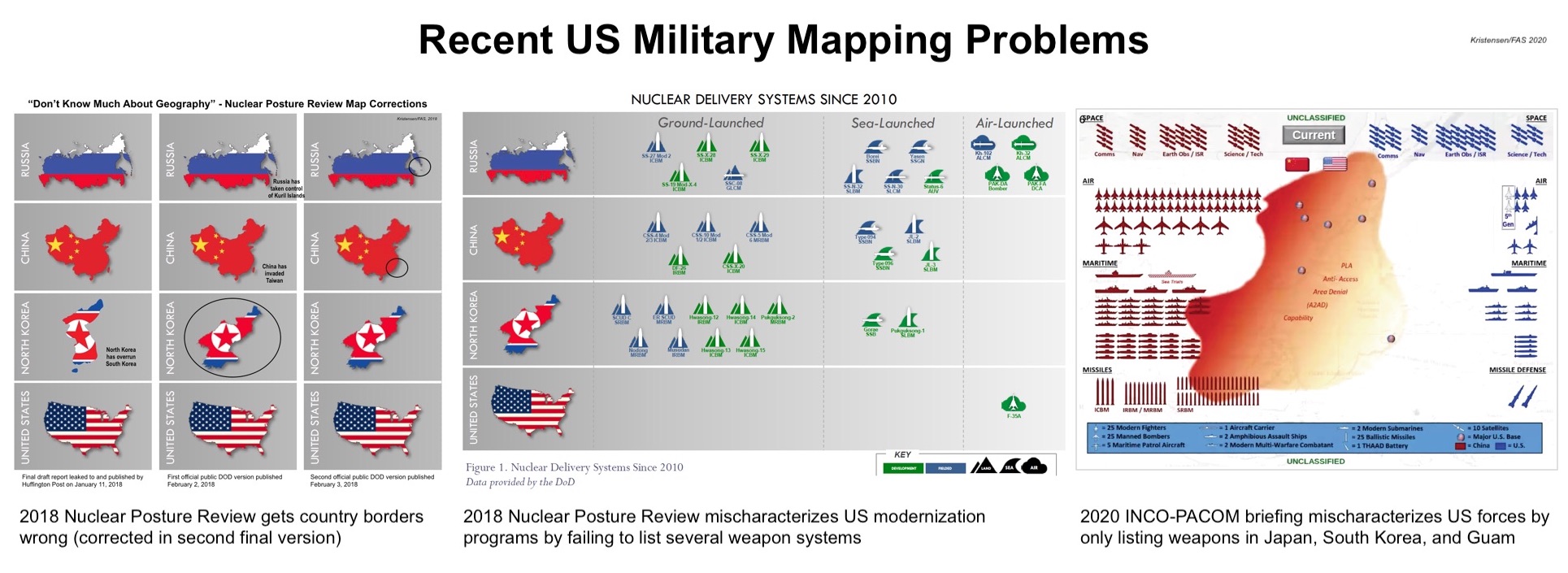(The Other) Red Storm Rising: INDO-PACOM China Military Projection

Click on image to download PDF-version of full briefing
Some Missile Numbers Do Not Match Recent DOD China Report
U.S. Indo-Pacific Command recently gave a briefing about the challenges the command sees in the region. The briefing says China is the “Greatest Threat to Global Order and Stability” and presents a set of maps that portray a massive Chinese military buildup and very little U.S. capability (and no Allied capability at all) to counter it. With its weapons icons and a red haze spreading across much of the Pacific, the maps resemble a new version of the Cold War classic Red Storm Rising.
Unfortunately, the maps are highly misleading. They show all of China’s forces but only a fraction of U.S. forces operating or assigned missions in the Pacific.
There is no denying China is in the middle of a very significant military modernization that is increasing its forces and their capabilities. This is and will continue to challenge the military and political climate in the region. For decades, the United States enjoyed an almost unopposed – certainly unmatched – military superiority in the region and was able to project that capability against China as it saw fit. The Chinese leadership appears to have concluded that that is no longer acceptable and that the country needs to be able to defend itself.
In describing this development, however, the INDO-PACOM briefing slides make the usual mistake of overselling the threat and under-characterizing the defenses. Moreover, some of the Chinese missile forces listed in the briefing differ significantly from those listed in the recent DOD report on Chinese military developments. As military competition and defense posturing intensify, expect to see more of these maps in the future.
Apples, Oranges, and Cherry-Picking
The INDO-PACOM maps suffer from the same lopsided comparison and cherry-picking that handicapped the 2018 Nuclear Posture Review: it overplays the Chinese capabilities and downplays the U.S. capabilities (see image below). While he briefing maps includes all of China’s military forces, whether they are postured toward India or Russia, it only shows a small portion of U.S. forces. INDO-PACOM mapmakers may argue that it’s only intended to show the force level in the Western Pacific theater, but INDO-PACOM spans all of the Pacific and the maps ignore other significant U.S. forces that are operating in the region to oppose China.
The INDO-PACOM map gives the impression that the United States only has 175 fighter-jets, 12 bombers, 50 maritime patrol aircraft, 1 aircraft carrier, four amphibious assault ships, 12 modern multi-warfare warships, 10 submarines, and 2 THAAD missile defense batteries in the region to deter China. In reality, the U.S. military forces based or assigned missions in the INDO-PACOM area of responsibility are significantly greater. The map excludes everything based in Hawaii, in Alaska, on the U.S. west coast, and elsewhere in the continental United States with missions in the Pacific or forces rotating through bases in the Indo-Pacific region. Examples of mischaracterizations of U.S. forces include:
Fighter aircraft: The map lists only lists 175 fighter-jets, but Pacific Air Forces says it has “Approximately 320 fighter and attack aircraft are assigned to the command with approximately 100 additional deployed aircraft rotating on Guam.”
Bombers: The map lists only 12 bombers, but the United States has more than 150 bombers, many of which would be used to counter Chinese forces in a war. Moreover, those bombers are considerably more capable than Chinese bombers and are supported by tankers to provide unconstrained range in the Pacific, something Chinese bombers cannot do.
Submarines: The map lists only 10 U.S. submarines, but according to the U.S. Naval Vessel Register the U.S. Navy has more than three times that many (35) in the Pacific, including 25 attack submarines, 2 guide missile submarines, and 8 ballistic missile submarines (SSBNs) homeported in Pacific ports. The omission of the 8 Pacific-based SSBNs is particularly problematic given their important role of targeting China – and that they are assigned up to eight times more nuclear warheads than China has in its entire nuclear weapons stockpile.

The INDO-PACOM briefing does not show that the United States has any ballistic missile submarines in the Pacific, even though eight U.S. Pacific-based SSBNs play a central role in targeting China. Just two of these Ohio-class SSBNs can carry more warheads than China has in its entire nuclear stockpile. This image shows the USS Pennsylvania (SSBN-735) during a port visit to Guam in 2016.
Aircraft carriers: The map lists only one U.S. aircraft carrier, but according to the U.S. Naval Vessel Register the U.S. Navy has six aircraft carriers based in the Pacific (two of them in shipyard). Moreover, unlike China’s single aircraft carrier (a second is fitting out), U.S. carriers are large flat-tops with more aircraft.
Amphibious assault ships: The map shows four U.S. amphibious assault ships, but the U.S. Pacific Fleet says it operates six (although one was recently damaged by fire). Moreover, the amphibious assault ships are being upgraded to carry the F-35B VSTOL aircraft, significantly improving their strike capability.
Missile defense: The map shows only two THAAD batteries but does not mention the Ground Based Midcourse missile defense system in Alaska. Nor are missile defense interceptors deployed on cruisers and destroyers listed.
ICBMs: One of the most glaring omissions is that the maps do not show the United States has any ICBMs (the map also does not list U.S. SLBMs but nor does it list Chinese SLBMs). Although U.S. ICBMs are thought to be mainly assigned to targeting Russia and would have to overfly Russia to reach targets in China, that does not rule out they could be used to target China (Chinese ICBMs would also have to overfly Russia to target the continental United States). U.S. ICBMs carry more nuclear warheads than China has in its entire nuclear stockpile.
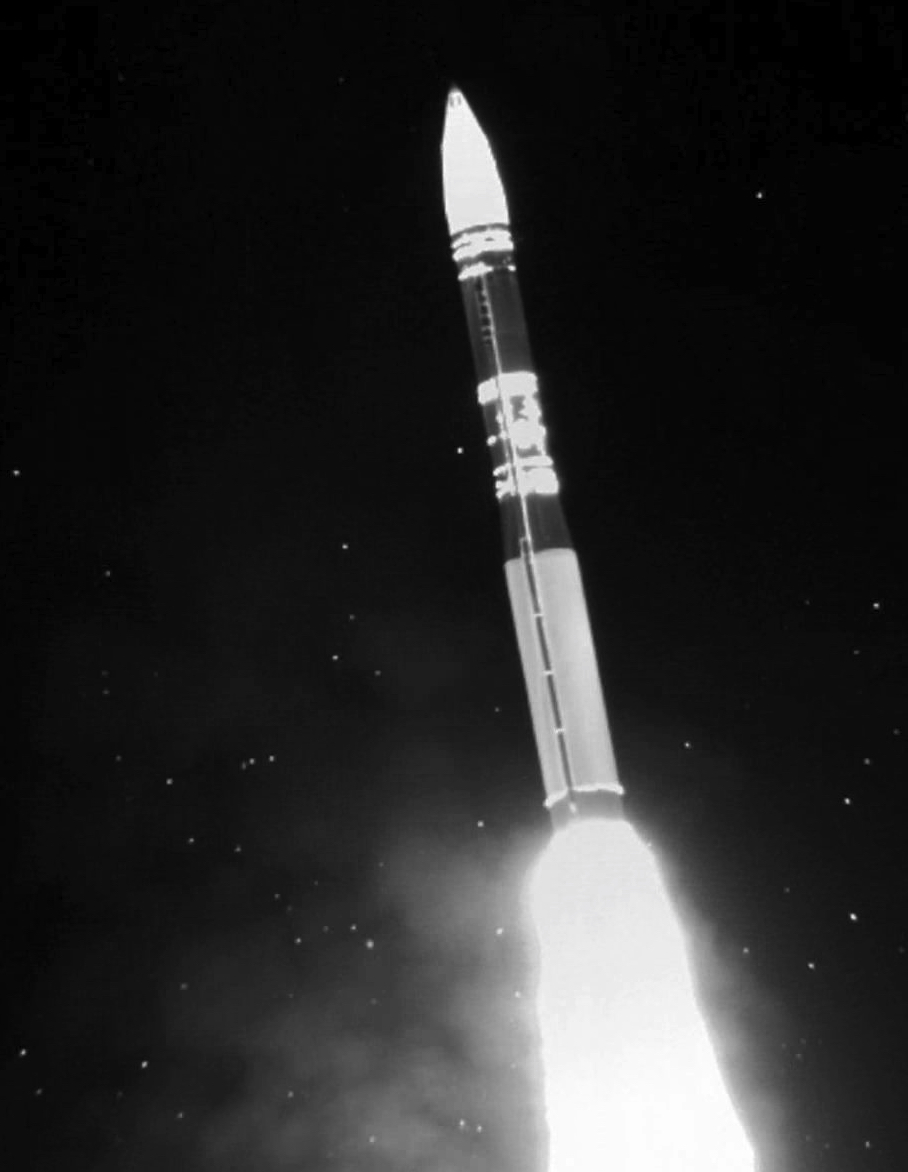
The INDO-PACOM briefing shows China with 100 ICBMs and the United States with none. This infrared image shows a U.S. Minuteman III ICBM test-launched from Vandenberg AFB into the Pacific on September 2, 2020.
A modified map, apparently made available by U.S. Pacific Air Forces, is a little better because it includes Australian, Japanese, and South Korean forces. But it still significantly mischaracterizes the forces the United States has in the Pacific or are assigned missions in the region. Moreover, the new map does not include the yellow highlights showing “hypersonics” missiles and portion of aircraft, ships, and submarines that are modern (see modified map below).
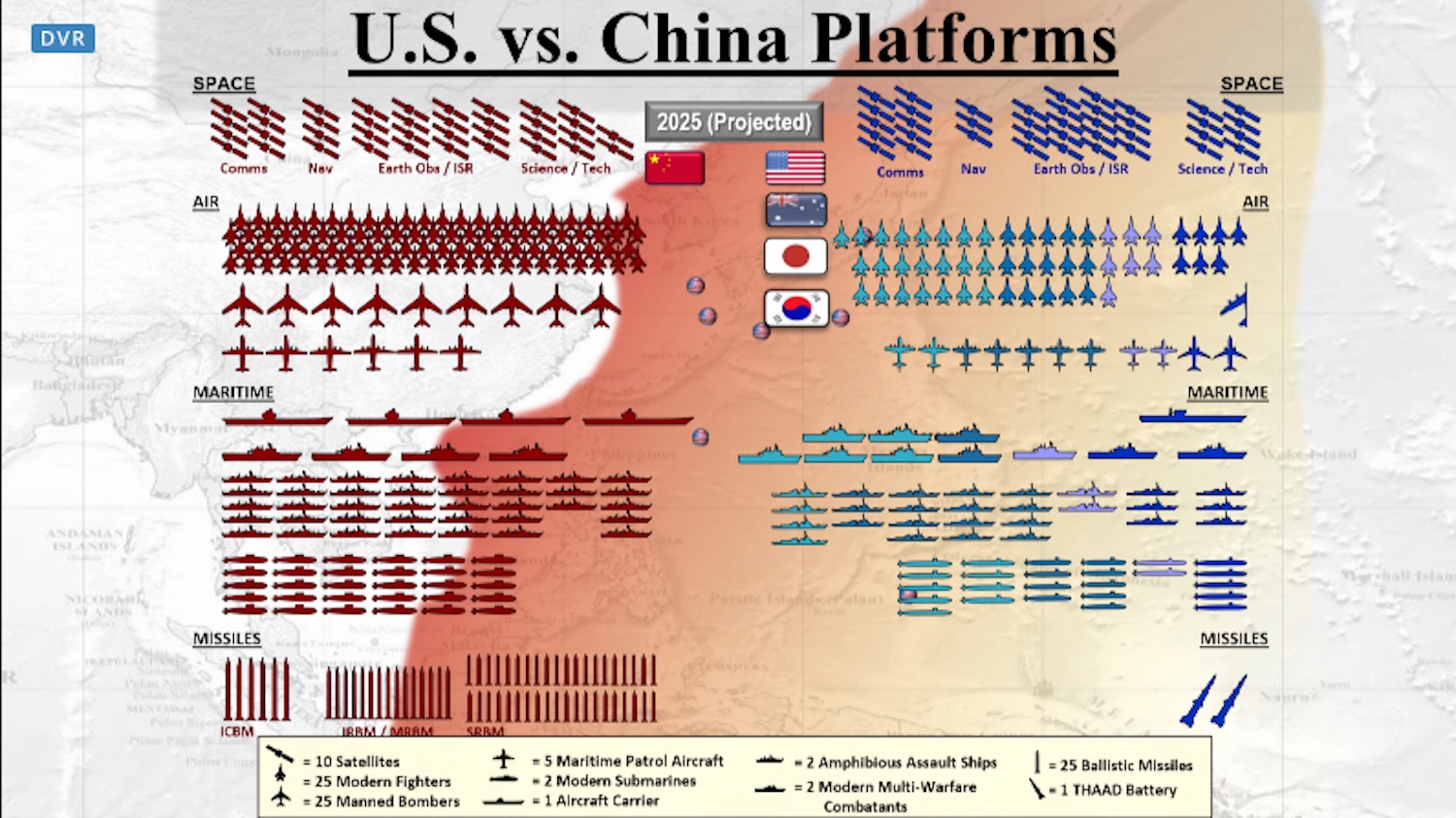
A modified map released after the INDO-PACOM briefing also shows Australian, Japanese, and South Korean forces – but still mischaracterizes U.S. military forces in the Pacific.
Inconsistent Missile Numbers
The INDO-PACOM maps are also interesting because the numbers for Chinese IRBMs and MRBMs are different than those presented in the 2020 DOD report on Chinese military developments. INDO-PACOM lists 250 IRBMs/MRBMs, more than 100 missiles fewer than the DOD estimate. China has fielded one IRBM (DF-26), a dual-capable missile that exists in two versions: one for land-attack (most DF-26s are of this version) and one for anti-ship attack. China operates four versions of the DF-21 MRBM: the nuclear DF-21A and DF-21E, the conventional land-attack DF-21C, and the conventional anti-ship DF-21D.
There is also a difference in the number of SRBMs, which INDO-PACOM sets at 1,000, while the DOD report lists 600+. The 600+ could hypothetically be 1,000, but the INDO-PACOM number shows that the high-end of the 750-1,500 range reported by the 2019 DOD China report probably was too high.
A comparison (see table below) is complicated by the fact that the two reports appear to use slightly different terminology, some of which seems inconsistent. For example, INDO-PACOM lists “missiles” but the low IRBM/MRBM estimate suggests it refers to launchers. However, the high number of SRBMs listed suggest it refers to missiles.
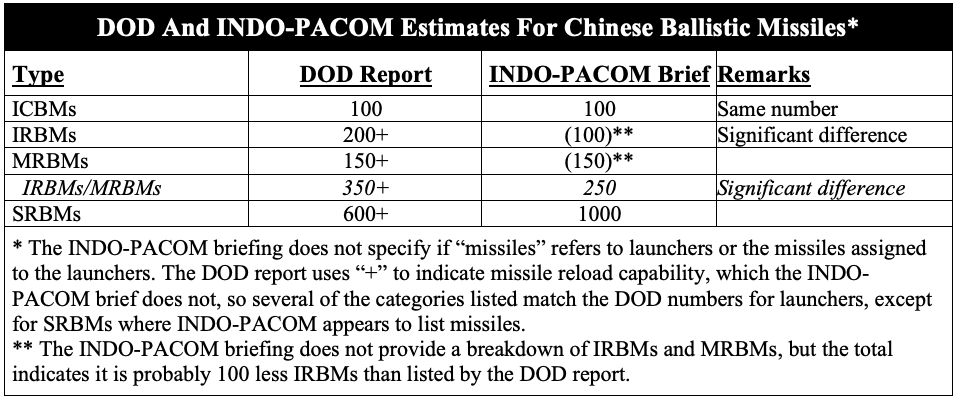
Several of the Chinese missile estimates provided by INDO-PACOM and DOD are inconsistent.
2025 Projection
The projection made by INDO-PACOM for 2025 shows significant additional increases of Chinese forces, except in the number of SRBMs.
The ICBM force is expected to increase to 150 missiles from 100 today. That projection implies China will field an average of 10 new ICBMs each year for the next five years, or about twice the rate China has been fielding new ICBMs over the past two decades. Fifty ICBMs corresponds to about four new brigades. About 20 of the 50 new ICBMs are probably the DF-41s that have already been displayed in PLARF training areas, military parades, and factories. The remaining 30 ICBMs would have to include more DF-41s, DF-31AGs, and/or the rumored DF-5C, but it seems unlikely that China can add enough new ICBM brigade bases and silos in just five years to meet that projection.
The briefing also projects that 50 of the 150 ICBMs by 2025 will be equipped with “hypersonics.” The reference to “hypersonics” as something new is misleading because existing ICBMs already carry warheads that achieve hypersonic speed during reentry. Instead, the term “hypersonics” probably refers to a new hypersonic glide vehicle. It is unclear from the briefing if INDO-PACOM anticipates the new payload will be nuclear or conventional, but a conventional ICBM payload obviously would be a significant development with serious implications for crisis stability. Even if this expansion comes true, the entire Chinese ICBM force would only be one-third of the size of the U.S. ICBM force. Nonetheless, a Chinese ICBM force of 100-150 is still a considerable increase compared with the 40 or so ICBMs it operated two decades ago (see graph below).

The INDO-PACOM briefing appears to show a greater increase in ICBMs projected for the next five years than DOD reported in the past decade.
The IRBM/MRBM force is projected to increase to 375, from 250 today. That projection assumes China will field 125 additional missiles over five years, or 25 missiles each year. That corresponds to a couple of new brigades per year, which seems high. Yet production is significant and IRBM launchers have been seen in several regions in recent years. The IRBM/MRBM force presumably would include the DF-17, DF-21, and the DF-26.
About 75-87 of the IRBM/MRBM force will be equipped with “hypersonics” by 2025, according to INDO-PACOM. That projection probably refers to the expected fielding of the DF-17 with a new glide-vehicle payload, although that would imply a lot of the new launcher (enough for 4-6 brigades). Another possibly is that a portion of other IRBMs/MRBMs (perhaps the DF-26) might also be equipped with the new payload or have their own version. China has presented the DF-17 as conventional but STRATCOM has characterized it as a “new strategic nuclear system.” Adding new hypersonics to IRBMs/MRBMs that are already mixing nuclear and conventional seems extraordinarily risky and likely to further exacerbate the danger of misunderstandings.

The INDO-PACOM does not list any DF-17s but projects that 75-87 of China’s IRBMs/MRBMs by 2025 will carry some form of hypersonic payload that is different from what they carry today.
The status and projection for the surface fleet are also interesting. The INDO-PACOM briefing lists the total number of aircraft carriers, amphibious assault ships, and modern multi-warfare combatant vessels at 54, of which 46 are modern multi-warfare combatant vessels. The briefing doesn’t specify what is excluded from this count, but it differs significantly from the count in the DOD China report.
One of the puzzling parts of the INDO-PACOM briefing is the projection that China by 2025 will be operating four aircraft carriers for fixed-wing jets. China is currently operating one carrier with a second undergoing sea-trials. How China would be able to add another three carriers in five years is a mystery, not least because the third and fourth hulls are of a new and more complex design. The projection also doesn’t fit with the U.S. Office of Naval Intelligence, which predicts the third carrier won’t be commissioned until 2024.
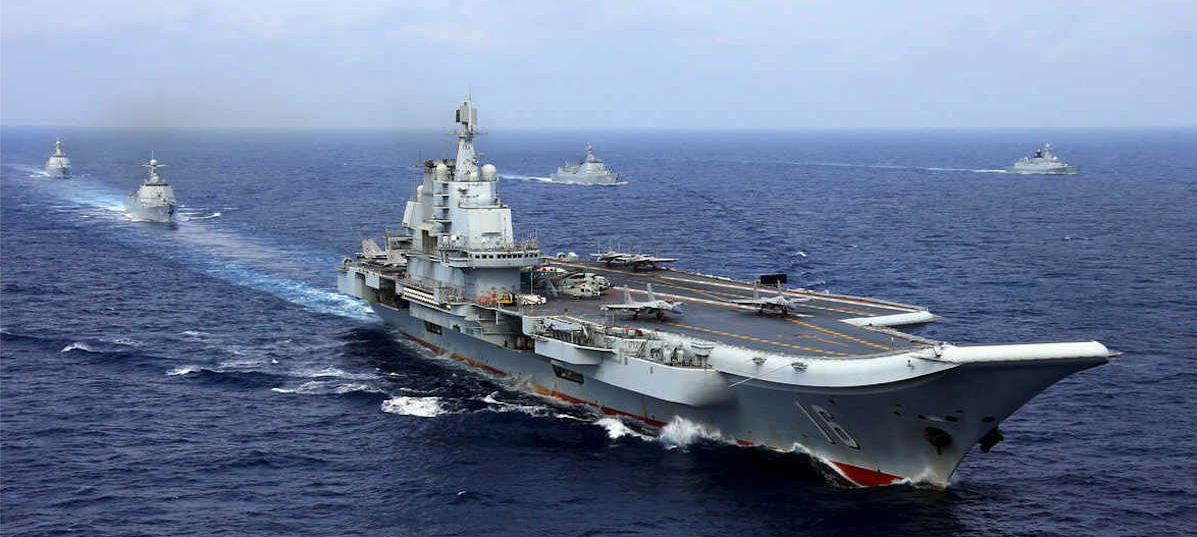
The INDO-PACOM briefing says China will operate four aircraft carriers by 2025 but ONI estimates the third won’t be commissioned until 2024.
Bombers are projected to increase from 175 today to 225 in 2025, an increase of nearly 30 percent. Since 2025 is probably too early for the new H-20 to become operational, the increase appears to only involve modern version of the H-6 bomber. Although the bomber force has recently been reassigned a nuclear mission, the majority of the Chinese bomber force will likely continue to be earmarked for conventional missions.
Submarines and surface vessels will also increase and some of them are being equipped with long-range missiles. Combined with the growing reach of ground-based ballistic missiles and air-delivered cruise missiles, this results in the INDO-PACOM maps showing a Chinese “anti-access area denial” (A2AD) capability bleeding across half of the Pacific well beyond Guam toward Hawaii. But A2AD is not a bubble and weakens significantly in areas further from Chinese shores.
Conclusion and Recommendations
The INDO-PACOM maps project China’s military modernization will continue at a significant pace over the next five years with increases in delivery platforms and capabilities. This will reduce the military advantage the United States has enjoyed over China for decades and further stimulate modernization of U.S. and allied military forces in the region. As forces grow, operations increase, and rhetoric sharpens, insecurity and potential incidents will increase as well and demand new ways of reducing tension and risks.
The Trump administration is correct that China should be included in talks about limiting forces and reducing tension. So far, however, the administration has not presented concrete ideas for what that could look like. Like the United States, China will not accept limits on its forces and operations without something in return that Beijing sees as being in its national interest. Although China is modernizing its nuclear forces and appears intent on increasing it further over the next decade, the force will remain well below the level of the United States and Russia for the foreseeable future. Insisting that China should join U.S.-Russian nuclear talks seems premature and it is still unclear what the United States would trade in return for what. In the near-term, it seems more important to try to reach agreements on limiting the increase of conventional forces and operations.
Unfortunately, the INDO-PACOM briefing does a poor job in comparing Chinese and U.S. forces and suffers from the same flaw as the 2018 Nuclear Posture Review by cherry-picking and mischaracterizing force levels. It is tempting to think that this was done with the intent to play up the Chinese threat while downplaying U.S. capabilities to assist public messaging and defense funding. But the Chinese military modernization is important – as is finding the right response. Neither the public nor the Congress are served by twisted comparisons.
It would also help if the Pentagon and regional commands would coordinate and streamline their public projections for Chinese modernizations. Doing so would help prevent misunderstandings and confusion and increase the credibility of these projections.
Finally, these kinds of projections raise a fundamental question: why does the Pentagon and regional military commands issue public threat projections at all? That should really be the role of the Director of National Intelligence, not least to avoid that U.S. public intelligence assessments suffer from inconsistencies, cherry-picking, and short-term institutional interests.
This publication was made possible by generous contributions from the John D. and Catherine T. MacArthur Foundation, the New Land Foundation, the Ploughshares Fund, and the Prospect Hill Foundation. The statements made and views expressed are solely the responsibility of the authors.
While it is reasonable for governments to keep the most sensitive aspects of nuclear policies secret, the rights of their citizens to have access to general knowledge about these issues is equally valid so they may know about the consequences to themselves and their country.
Nearly one year after the Pentagon certified the Sentinel intercontinental ballistic missile program to continue after it incurred critical cost and schedule overruns, the new nuclear missile could once again be in trouble.
“The era of reductions in the number of nuclear weapons in the world, which had lasted since the end of the cold war, is coming to an end”
Without information, without factual information, you can’t act. You can’t relate to the world you live in. And so it’s super important for us to be able to monitor what’s happening around the world, analyze the material, and translate it into something that different audiences can understand.
